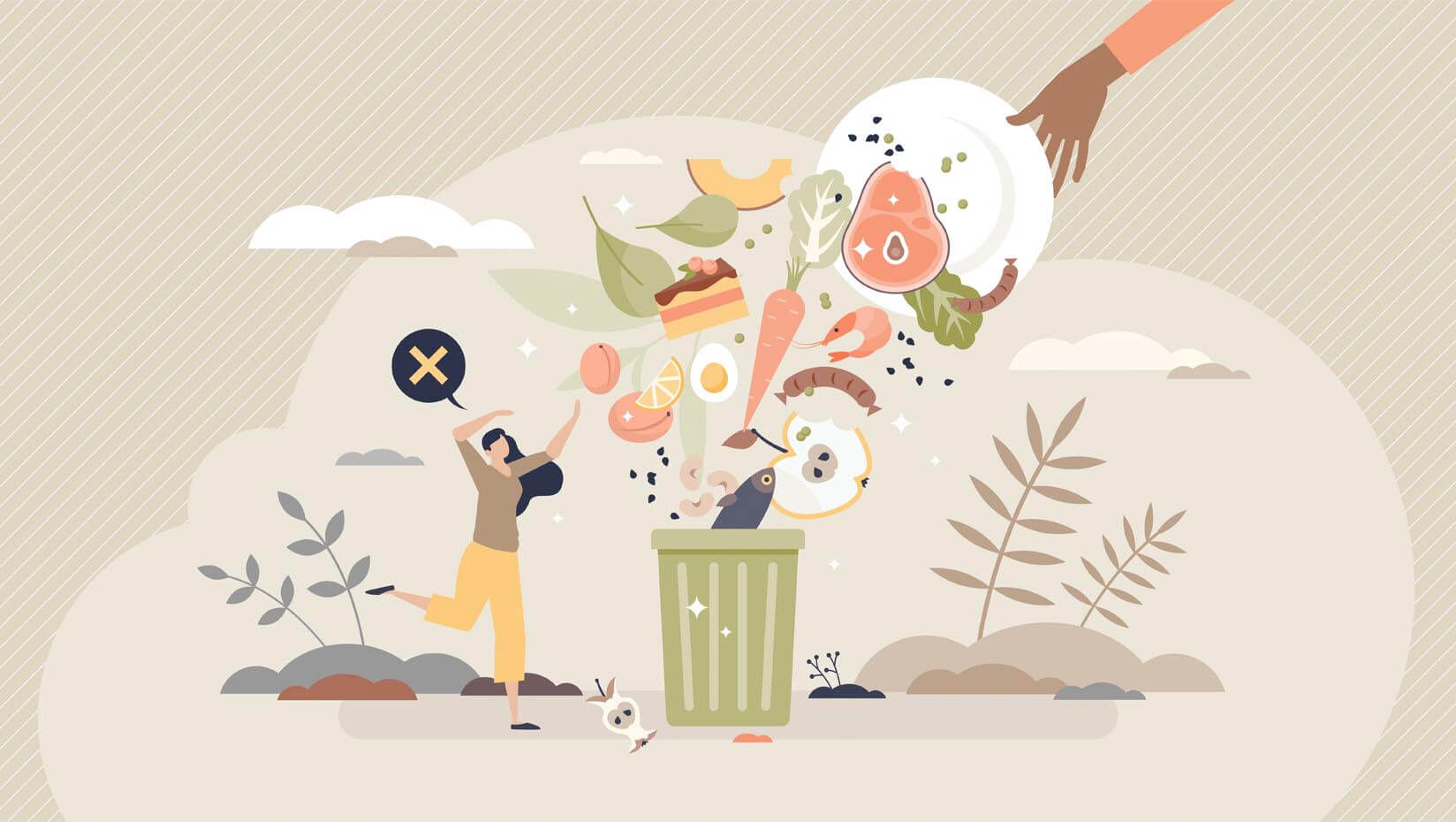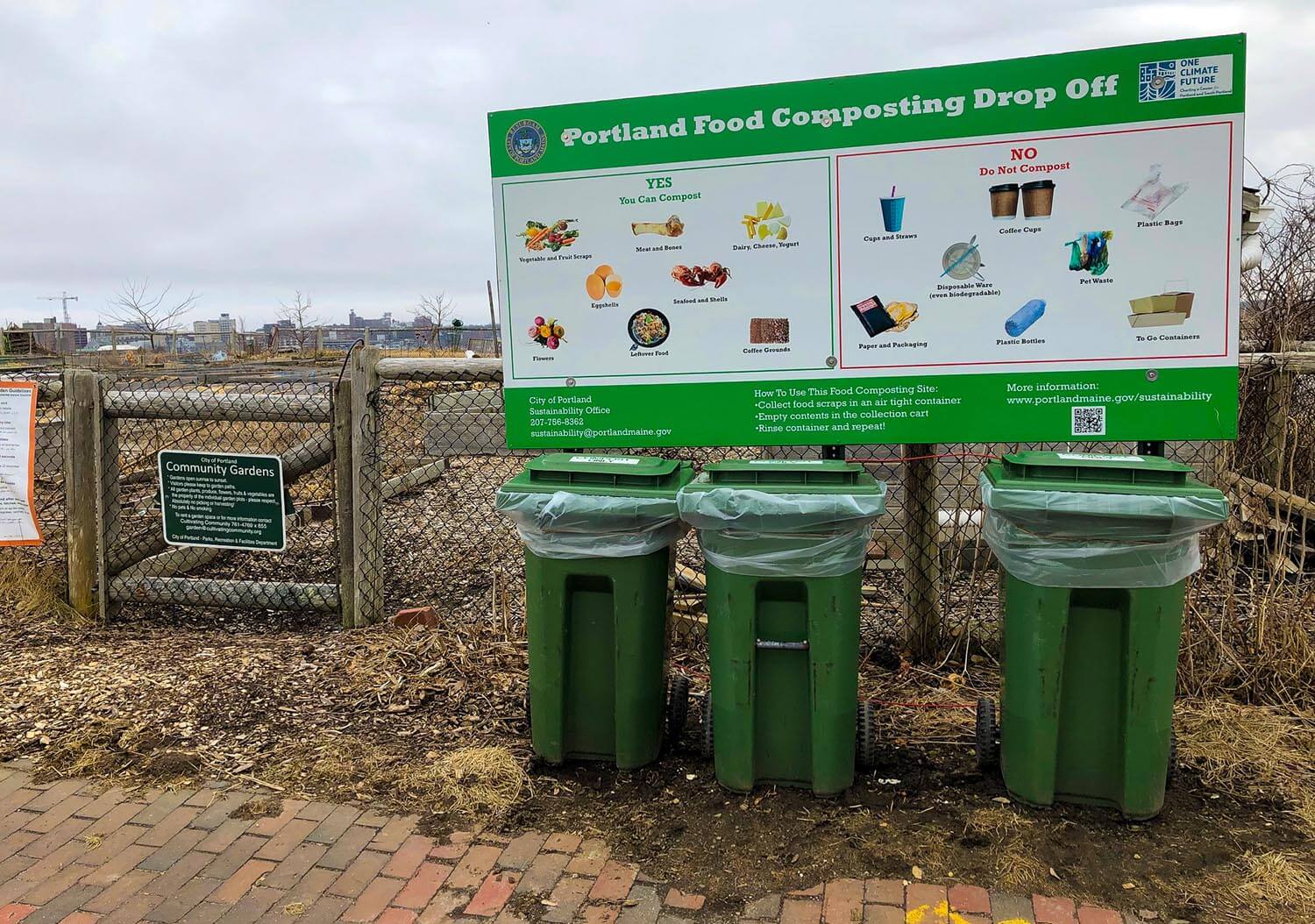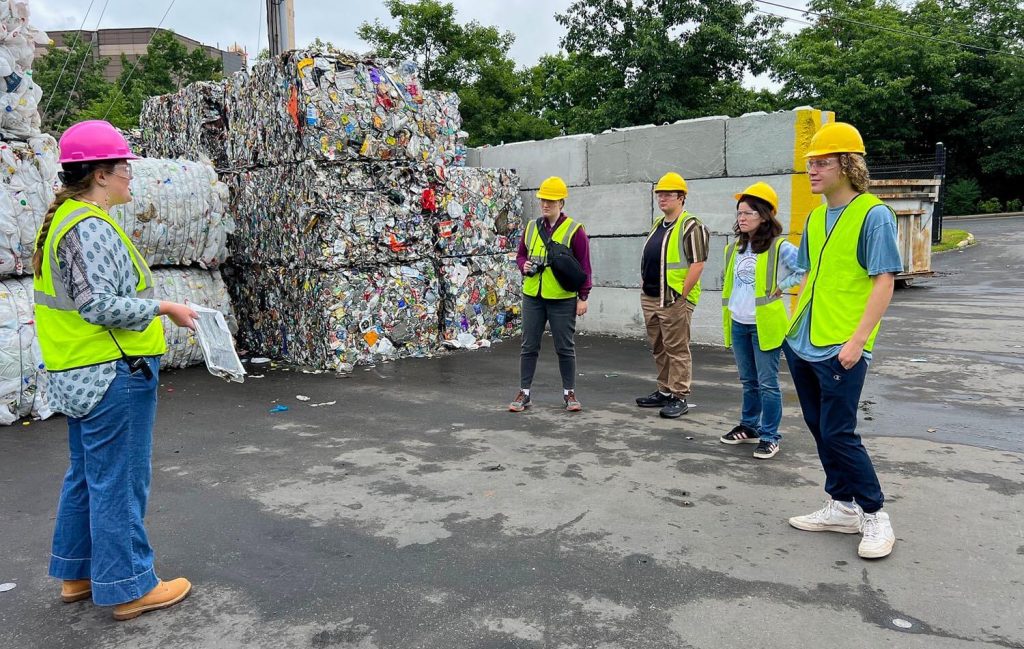
UMaine-led first-of-its-kind food waste study shines light on where food is wasted in Maine
Addressing the breadth of issues related to food surplus, loss and waste — which span across economic, social and environmental sectors — is a herculean task for any state.
As Maine works to better understand and address the complex problem of food waste, the Maine Department of Environmental Protection (DEP) tapped a team of researchers, including those from University of Maine’s Senator George J. Mitchell Center for Sustainability Solutions, to produce the Maine Food Loss and Waste Generation Study, a first-of-its-kind investigation that provides key Maine food waste data.
“In recognition of Maine Food Waste Awareness Week this week, we would encourage all Maine people to take a look at this important study to see the amount of food wasted and where it’s coming from,” said Susanne Lee, study co-author and faculty fellow with the Mitchell Center. “Just by taking a look at the quick two-page summary, it’s easy to see that Maine households are a major generator of food waste, which means that we all have a big opportunity to help reduce the waste.”
Why study food waste in Maine?
Food waste leads to economic, social and environmental damage. Food waste in landfills releases greenhouse gasses, including carbon dioxide, hydrogen sulfide, nitrous oxide and methane. Wasting food also wastes money — not just the money spent when consumers purchase it, but the money and time put into making and managing it.
“When we waste food, we also waste the resources that went into producing it: growing (water, labor, fertilizer, etc.), harvesting, processing, transporting, preparing for market, storing and final disposition,” said Mark King, organic management specialist at the Maine Department of Environmental Protection (DEP).
Keeping food out of the waste stream and reallocating it to people in need can help tackle food insecurity in Maine, which is the highest in New England. According to Feeding America, 180,000 people in Maine — about one in eight — experienced food insecurity in 2022, including one in five children.
Maine is also the only state in New England without an “organics ban” — essentially, a law that prohibits food and other organic materials like yard waste from being disposed of in landfills.. Several efforts have been made to implement an “organics ban” over the past eight years, but King said one might be passed in the next legislative session because of increased interest from Maine citizens.
In addition to the legislative interest, the state’s Climate Action Plan will be renewed in December 2024, and the Maine DEP hopes to add food waste to the priorities for the revamped plan. Maine’s first Climate Action Plan, released in December 2020, did not include any kind of waste or other material management goals or recommendations. Since that time, food waste has been increasingly identified by the United Nations and U.S. Environmental Protection Agency as a key driver of climate change.
Recruiting the Mitchell Center
In December 2023, the Maine DEP decided to recruit a team of researchers to conduct a first-of-its-kind study about the origins, quantities, types and quality of surplus food, food scraps and food waste in Maine. The department received funding through the Governor’s Office of Policy Innovation and the Future (GOPIF), and put out a request for proposals (RFP).
Susanne Lee, faculty fellow at the Mitchell Center and program lead of the interdisciplinary Food Rescue MAINE team, saw the study as a great opportunity. The Mitchell Center Materials Management team had already been working closely with the DEP and other key stakeholders on the food waste issue, and knew intimately of the need for better food waste data.
“The Mitchell Center operates as a partner to the state in solving these really complex problems where economic consideration, social considerations and environmental considerations collide. It’s hard to say how big the problem is; you have to have the data in order to do anything about it. It was literally important because it’s the first step, it’s the gateway to all the solutions,” Lee said.
The Mitchell Center, with their strong understanding of Maine’s food waste infrastructure and network, teamed up with Resource Recycling Systems (RRS), a sustainability and recycling consulting firm based in Ann Arbor, Michigan, that specializes in food waste data, models and analytics, to submit a proposal. To combine the data and models with interviews across different sectors, they also collaborated with Massachusetts-based CET, based on their strong food waste and data gathering expertise.
Conducting the study
Once the food waste research dream team was selected, it was time to gather the data. RRS developed the methodology, managed data collection oversight and conducted the in-depth analysis to compute food loss and waste across the studied sectors in Maine, using sources and rates based on primary information from studies from the Mitchell Center. CET conducted interviews across the sector to understand where waste moves. Lee and her team at UMaine, co-led by Travis Blackmer, lecturer at the School of Economics, helped to provide connections and leads as well as direct interviews with key contacts and subject experts.
Lee said that one of the goals of the study was to provide food waste management recommendations. During the interviews, the researchers tried to make an effort to understand what the sectors were already doing to address food waste.
“We were also talking to them about what kind of actions they’re taking, what more they could do with additional infrastructure and support,” Lee said.
Still, the work could be challenging. Kirsten Wille, project manager at CET, said that some places are nervous about letting people who are reporting to the state look through their trash — literally. Wille said that commercial businesses were reluctant to provide information because they were worried it would lead to a food waste ban or regulation that would impact their bottom line.
“Because our team knows this business so well and understands the customer’s experience so well, we can frame questions in ways that are far less intimidating and threatening. We have a practice of meeting our customers where they are in the work that they do,” Wille said.
By combining their unique resources and experiences, RRS, UMaine and CET were able to compile an enormous amount of data. Over four months of calling businesses and crunching numbers, the team published a comprehensive report in April that details where food waste and loss is generated in Maine.
The final report
The final report looks at food waste in 15 sectors — including hospitals, schools and households — and breaks it down by county.
The main findings included that approximately 361,000 tons of food loss and waste are generated annually in Maine, a figure that King said was “surprising” in its immensity. Overall, that is almost 40% of all waste produced in the state.
The study showed that the residential and agricultural sectors are the most significant contributors, together producing 61% of Maine’s food loss and waste. Commercial food loss and waste are most prevalent in Cumberland and York counties, which have the highest population density and concentration of businesses.
“Another important observation highlights the impact of seasonal tourism, with particular effect on the hospitality sector,” said Hunt Briggs, senior consultant and organics practice lead at RRS. “Fluctuations in population lead to substantial changes in the rate that food waste arises in consumer-facing businesses throughout the year, so venues such as sports arenas and festivals, for example, can experience short but intense periods of high waste generation. This signals the need for flexible and adaptable approaches to waste management.”
The report offered preliminary solutions to the food waste problem, such as food scrap diversion for commercial businesses.
“It talks about the charitable food systems, what is our capacity and how does the charitable food system play into that,” Lee said. “You can’t really expect the charitable food systems to take all your wasted food and food loss. If you send everything to the pantry, then they bear the cost of having to dispose of it.”
The study also found that only eight facilities in Maine have the collective capability to process nearly 84,000 tons annually of wasted organic material that cannot be mitigated or recovered through other means.
The report led to draft recommendations from the GOPIF Materials Management Task Force to the Maine Climate Council (which Lee is also involved with) that were presented in June 2024. Megan Mansfield-Pyror, waste management climate policy advisor at GOPIF and member of the task force, said that one of the goals of the recommendations is to make Mainers more aware of the connection between food waste and climate. She also hopes the draft recommendations will spur more local and individual food waste action, like composting.
She also said that the Mitchell Center has been instrumental in making work like this possible.
“A lot of the work we do in state government couldn’t happen without the Mitchell Center. I think the Mitchell Center is our most important partner in all this,” she said.
Beyond the report
According to Lee, the most important finding from the study is that there needs to be more data on food waste in Maine.
The Maine DEP has already begun working on a waste characterization study looking at the types of waste generated in the state, and what is needed to divert it. That study will also help address some nuances in food waste.
“For example, not all food waste is the same,” Lee said. “Food waste can be considered to be edible by people, edible by animals or completely inedible. In addition, it can be considered avoidable, such as leftovers, or unavoidable, like fruit rinds or coffee grounds. Finally, there is wasted food and food loss that is actually being recovered or recycled, which actually makes it no longer wasted food.
King said that Maine DEP’s Waste Characterization Study is due by the end of this year. He hopes to use the results to verify the Food Loss and Waste Generation Study values, identify infrastructure gaps and determine where future resources and efforts should be concentrated to minimize food losses.
“We hope to put the two together and look at where they complement each other,” King said. “We don’t know what’s going to be the best approach until we know what the major problems are. We’re going to spend a tremendous amount of time digesting both reports together.”
A new generation of researchers
While the state is leading the next food waste study, UMaine is already working towards gathering more information for the recommendations too. Food Rescue MAINE, the group Lee runs, has recruited some new researchers to expand on the study: UMaine undergraduates.
Megan Sauberlich, a junior majoring in economics, spent the summer on a project in partnership with Northern Light Health Care System and Eastern Maine Medical Center to track and measure food waste in the hospital sector. Sauberlich is collecting the sector’s food waste data to inform future food waste solutions, whether through reduction, recovery, recycling or education.
“We’re really trying to get stakeholders curious about the process and educating them about how it might be beneficial to them in the long run,” Sauberlich said. “I think the focus on food insecurity in Maine correlates with [this] sector that is helping people.”
Sauberlich said that she didn’t know much about food waste when she started the position, but as soon as she started the work and learned more about Food Rescue MAINE, the more she saw how it related to her studies and her interests.
“It’s just a giant market that is unmet. There are a lot of people that need this food, but there’s a gap in understanding, awareness and things like that. I thought my major could bring something to the financial aspect of food waste in Maine,” Sauberlich said.
In that vein, the Mitchell Center and Food Rescue MAINE are also working on educating the public about food waste. Kathryn Busko is the communication and education intern managing the Food Rescue MAINE website and social media.
Busko, who also is a member of the Honors College, said that her main goal as an intern is to make food waste issues accessible and in “bite-sized chunks,” and posting actionable information to help Maine consumers reduce their food waste. She is particularly proud of the educational posts she has made for the Food Rescue MAINE Instagram.
“One of the most difficult parts of trying to communicate food waste is that a lot of people don’t realize they’re part of the problem,” Busko said. “The majority of people think that they waste less food than the average person, which is not possible. I think that says a lot about how we see our waste and how visible it is to us. Part of my goal is just making the things that I think about everyday more of a part of the everyday vocabulary.”
Busko said that the Food Rescue MAINE team is also looking towards a project that introduces the general public to key findings from the Maine Food Loss and Waste Generation Study, as well as another project that teaches Maine’s 15 million annual visitors how to reduce their food waste impact.
The ecology and environmental sciences major said that after hearing about the climate crisis “all the time” in her studies during her first year of college, she was eager to contribute to solutions.
“This internship allows me to contribute, in a small way, to this issue,” Busko said.
For researchers like Lee and her team, though, undergraduates like Sauberlich and Busko represent something else: the next generation of food waste researchers, working to solve a problem that will impact generations to come.
Story by Sam Schipani.
Contact: Ruth Hallsworth, hallsworth@maine.edu


